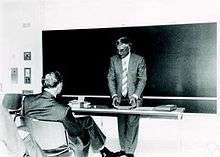Gerrit Lekkerkerker

Cornelis Gerrit Lekkerkerker (Harmelen, 7 February 1922 – 24 July 1999) was a Dutch mathematician.
Lekkerkerker studied mathematics at Utrecht University during the periods 1940-1943 and 1945-1949 under Jurjen Koksma and Jan Popken. In 1955 he received his doctorate under the guidance of Popken with the thesis On the Zeros of a Class of Dirichlet-Series; in Dutch: Over de nulpunten in een klasse van Dirichletreeksen.
After completing his studies in 1949, he started work at the Amsterdam Centrum Wiskunde & Informatica (National Research Institute for Mathematics and Computer Science), where he worked under Koksma in the pure mathematics division. In the academic year 1953-1954, he studied in Rome.
For 25 years, from 1961 to 1986, he was a professor at the University of Amsterdam, succeeding Nicolaas Govert de Bruijn. He was the director of the Mathematical Institute during the student protests of 1969-1973.
He worked on analytic and geometric number theory. He and wrote the standard text, Geometry of Numbers, first published in 1969. Later, he worked on topics in functional analysis. In the 1970s, he turned his attention towards the mathematical treatment of topics in nuclear physics (e.g. neutron transport) and astrophysics (e.g. radiation transport within stars). Afterwards, he worked with Rutger Hangelbroek, who did his doctorate under Lekkerkerker in 1973 at the University of Groningen, and Hans Kaper of the Argonne National Laboratory. He also contributed to topics in graph theory and topology.
In 1984, although he had not yet reached retirement age, he resigned his professorship over differences in the teaching of mathematical analysis, feeling that his academic freedom was under threat. He did, however, remain active in mathematics: for example, he brought out a second edition of Geometry of Numbers along with Peter Grüber. This field now found new applications in coding theory.
He was a co-editor of Mededelingen van het Wiskundig Genootschap (correspondence of the Mathematical Society).
Works
- With Peter Gruber, Geometry of Numbers, Noord-Holland, 1969, 2nd edition, 1987 (first edition by Lekkerkerker alone; also translated to Russian, Nauka, Moscow, 2008)
- with Hans Kaper, J. Hejmantek, Spectral methods in linear transport theory, Birkhäuser 1982
External links
- necrologie door Hendrik G.J Pijls, Nieuw Archief voor Wiskunde, September 2000
- Gerrit Lekkerkerker at the Mathematics Genealogy Project